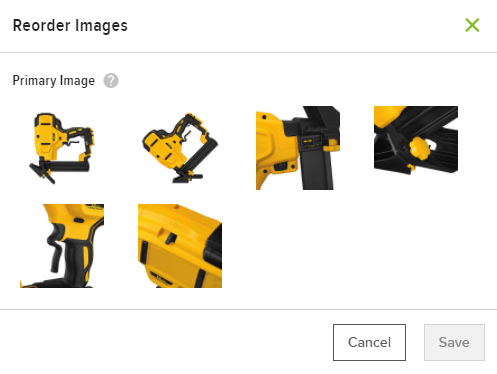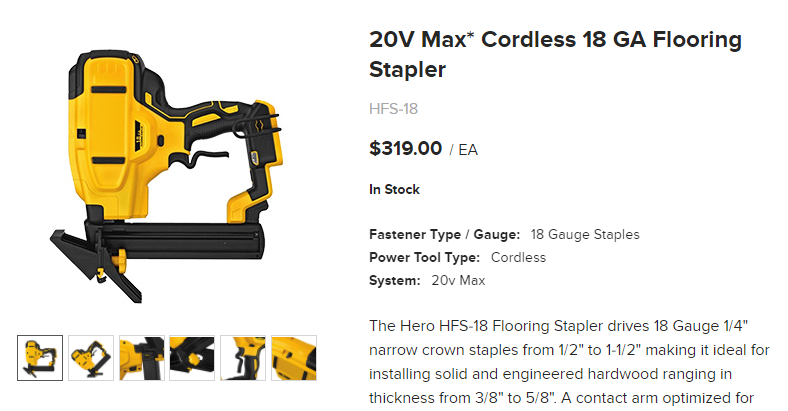 Uploading and assigning product images
Uploading and assigning product images
Displaying product images provides buyers with a clear view of what they are purchasing. This article provides the necessary steps to upload and add images to Products.
About images
B2B Commerce provides three different product image sizes: Small, Medium, and Large.
- Small - The small image is displayed on a variety of pages: Cart, Order Details, Review and Pay, Request for Quote, Quote Details, and Wishlists. The recommended size is 160x160.
- Medium - The medium image is displayed on the Product Detail page, Category page, within the Carousel widget A pre-configured content holder ISC_Content user roles may use to add content to website pages without having to develop page elements., and in the search box. The recommended size is 300x300.
- Large - The large image is displayed when a user selects an image to view it larger. The recommended size is 900x900.
The Medium image is required. It is used if the Small and Large image paths are not identified. However, Optimizely highly recommends adding an appropriately-sized/scaled image to each field for performance reasons. Greatly oversized medium images that must be scaled to fit small/large image paths may affect performance.
Image considerations
In most circumstances, using the same image for all three sizes provides a consistent user experience. For example, if a user selects the Product image on the Product Detail page, a larger version of the image is displayed. However, using a different Large image will display an entirely different image, not providing the expected user experience. This is because the Product Detail page uses the Medium image and the bigger, "zoomed in" image uses the Large image.
A different scenario, where using different images could be advantageous, would be to use the Medium image to show the product on a model and then use the Large image to show a close up the product- not including the model.
Regardless of what images are used, it is important to thoughtfully plan out images and how they will be displayed on the website. Be sure to use the image sizes and locations listed above as a reference point when making Product image decisions.
Adding images to products
Displaying multiple images to a Product provides buyers with a comprehensive view of what they are purchasing.To add images to Products, the image path for the Small, Medium, and Large images needs to be identified. This path is set at the Product level within the Admin Console. All images are stored either within the Media library, which is physically on the Optimizely web server, or within a Content Delivery Network. The steps below are only applicable to images stored within the Media library. To identify the path to the images, follow the steps below:
If no image is uploaded, the default "image not found" image  is used. Use the Small Default Product Image, Medium Default Product Image, and Large Default Product Image Settings to control which file is used for the "image not found" image.
is used. Use the Small Default Product Image, Medium Default Product Image, and Large Default Product Image Settings to control which file is used for the "image not found" image.
To add multiple images to a product:
- Go to Admin Console > Catalog > Products.
- Select Edit for the desired Product.
- Select the Images finger tab.
- Click Add Product Image.
- Give the image a Name, and determine its Sort Order.
The image with the lowest sort order (1) is assigned as the Primary Image. It appears throughout the site and by default on the product detail page.
- Click Browse to browse for a Small, Medium, or Large image.
The Medium image is required. If Large and Small images are not uploaded, the Medium image is resized automatically and used across the site where the Small and Large images normally appear.
- Double-click the desired image or select Choose in the upper left corner.
- Click Save.
Once images have been uploaded, reorder them to ensure the buyer sees the most dynamic image first. To reorder product images:
- Go to Admin Console > Catalog > Products.
- Select Edit for the desired Product.
- Select the Images finger tab.
- Select More Options, and select Reorder Images.

- Select an image, then drag and drop it to a new location in the list.
The image in the upper left corner (with the Sort Order of 1) is the Primary Image, and is the image shown across the site and by default on the Product Detail page.
- Select Save.
This is how multiple images appear on the Product Details page:

Select the thumbnails under the primary image to change the displayed image and select the primary image to zoom in and view the Large image.
Adding and assigning images using product import
Before proceeding with this method, all images need to exist either locally in the Media library, physically on the Optimizely web server, or a CDN. From there it is then necessary to add the file path or URL for each product and image size (small, medium, large) into the import spreadsheet. As you can imagine, this could be a very laborious task and is not recommended for large scale product/image assignments. This would likely be used as a one-off for small updates. Refer to the documentation on importing/exporting for more information on how to perform an import and how to use the import template.